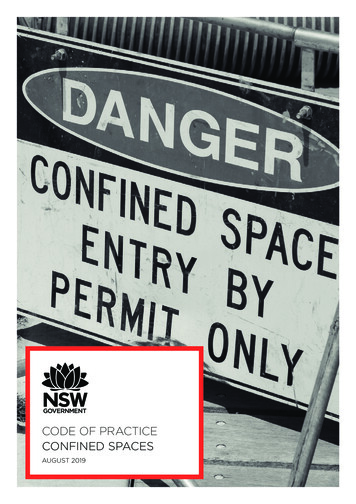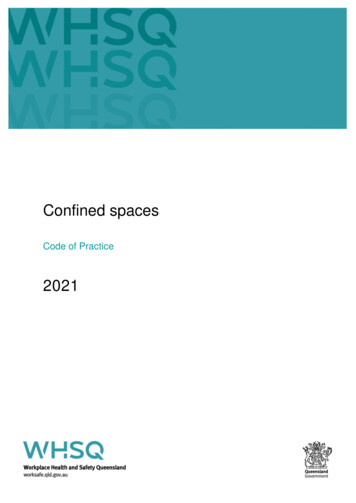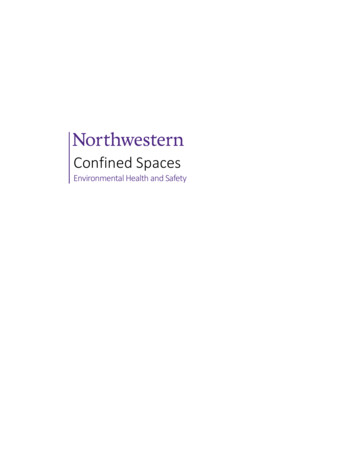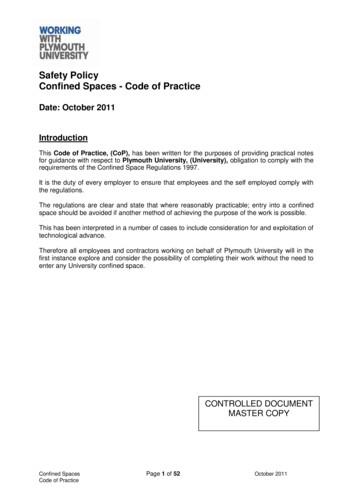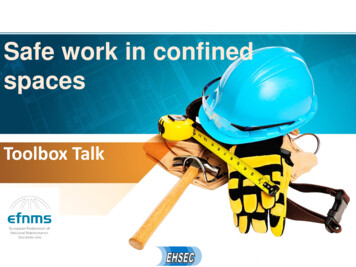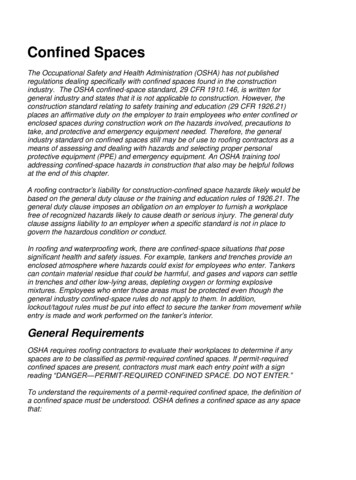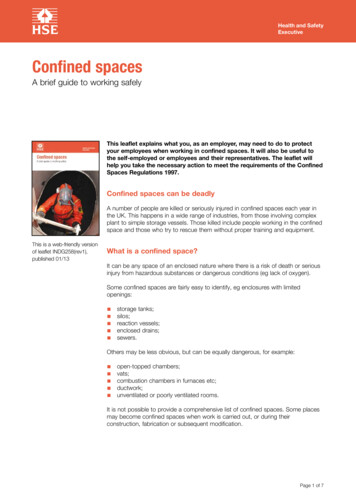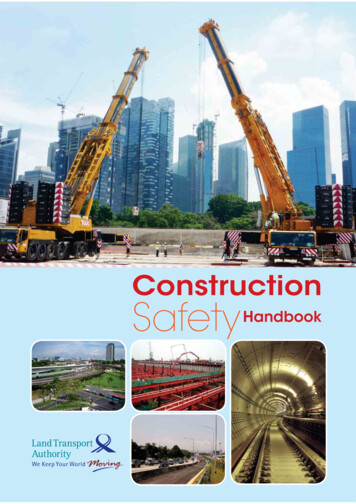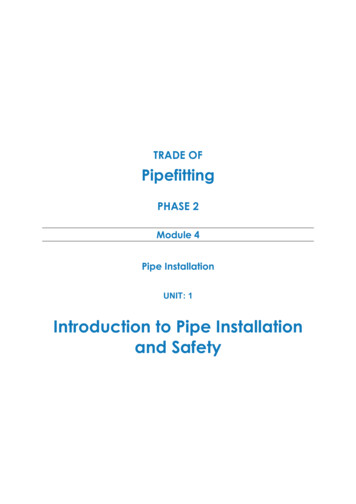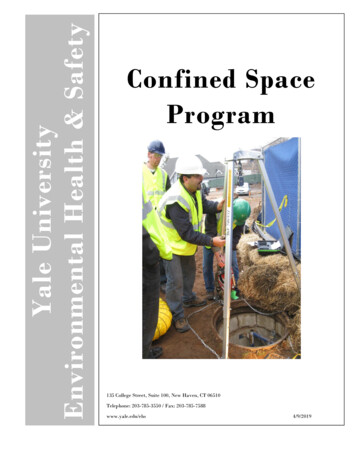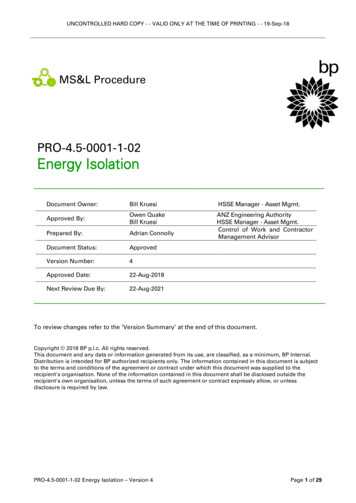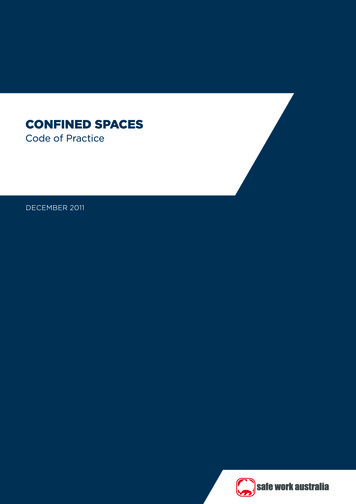
Transcription
CONFINED SPACESCode of PracticeDECEMBER 2011
Safe Work Australia is an Australian Government statutory agency established in 2009. Safe WorkAustralia consists of representatives of the Commonwealth, state and territory governments, theAustralian Council of Trade Unions, the Australian Chamber of Commerce and Industry and theAustralian Industry Group.Safe Work Australia works with the Commonwealth, state and territory governments to improvework health and safety and workers’ compensation arrangements. Safe Work Australia is anational policy body, not a regulator of work health and safety. The Commonwealth, states andterritories have responsibility for regulating and enforcing work health and safety laws in theirjurisdiction.ISBN 978-0-642-33313-1 [PDF]ISBN 978-0-642-33314-8 [RTF]Creative CommonsExcept for the logos of Safe Work Australia, SafeWork SA, Workplace Standards Tasmania,WorkSafe WA, Workplace Health and Safety QLD, NT WorkSafe, WorkCover NSW, Comcare andWorkSafe ACT, this copyright work is licensed under a Creative CommonsAttribution-Noncommercial 3.0 Australia licence. To view a copy of this licence, /au/In essence, you are free to copy, communicate and adapt the work for non commercial purposes,as long as you attribute the work to Safe Work Australia and abide by the other licence terms.Contact informationSafe Work AustraliaPhone: 61 2 6121 5317Email: info@safeworkaustralia.gov.auWebsite: www.safeworkaustralia.gov.auWORKSAFEWestern Australia
TABLE OF CONTENTSFOREWORD26.EMERGENCY PROCEDURES291.INTRODUCTION47.HOW TO REVIEW CONTROL MEASURES311.1What is a confined space?4APPENDIX A – CONFINED SPACE CRITERIA321.2Who has health and safety dutiesin relation to a confined space?5APPENDIX B – SAMPLE CONFINED SPACEENTRY PERMIT331.3What is required in managing risks?6LIST OF AMENDMENTS371.4How to determine whether a spaceis a confined space7ROLE OF DESIGNERS,MANUFACTURERS AND SUPPLIERS9Eliminating or minimising the needto enter a confined space92.2.12.2 Entry and exit93.HOW TO IDENTIFY THE HAZARDS113.1What hazards are associated witha confined space?113.2 Other hazards134.HOW TO ASSESS THE RISKS155.HOW TO CONTROL THE RISKS185.1The hierarchy of control185.2 Eliminate the need to entera confined space195.3 Minimise the risks195.4 Entry permits205.5 Isolation225.6 Atmosphere245.7 Communication and safety monitoring265.8 Entry and exit procedures275.9 Signs and barricades275.10 Information, instruction and training285.11 Maintenance of control measures28CODE OF PRACTICE CONFINED SPACES1
FOREWORDThis Code of Practice on how to manage the risks associated with confined spaces inworkplaces is an approved code of practice under section 274 of the Work Health and SafetyAct (WHS Act).An approved code of practice is a practical guide to achieving the standards of health, safetyand welfare required under the WHS Act and the Work Health and Safety Regulations (theWHS Regulations).A code of practice applies to anyone who has a duty of care in the circumstancesdescribed in the code. In most cases, following an approved code of practice would achievecompliance with the health and safety duties in the WHS Act, in relation to the subjectmatter of the code. Like regulations, codes of practice deal with particular issues and do notcover all hazards or risks that may arise. The health and safety duties require duty holdersto consider all risks associated with work, not only those for which regulations and codes ofpractice exist.Codes of practice are admissible in court proceedings under the WHS Act and Regulations.Courts may regard a code of practice as evidence of what is known about a hazard, riskor control and may rely on the code in determining what is reasonably practicable in thecircumstances to which the code relates.Compliance with the WHS Act and Regulations may be achieved by following anothermethod, such as a technical or an industry standard, if it provides an equivalent or higherstandard of work health and safety than the code.An inspector may refer to an approved code of practice when issuing an improvement orprohibition notice.This Code of Practice has been developed by Safe Work Australia as a model code ofpractice under the Council of Australian Governments’ Inter-Governmental Agreement forRegulatory and Operational Reform in Occupational Health and Safety for adoption by theCommonwealth, state and territory governments.A draft of this Code of Practice was released for public consultation on 7 December 2010and was endorsed by the Workplace Relations Ministers’ Council on 10 August 2011.2CODE OF PRACTICE CONFINED SPACES
FOREWORDSCOPE AND APPLICATIONThis Code provides practical guidance on how to meet the requirements under the WHSRegulations in relation to work carried out in a confined space. It applies to personsconducting a business or undertaking who have management or control of a confinedspace, and to designers, manufacturers or suppliers of plant or structures that include,or are intended to include, a confined space.This Code will help determine when a space is a ‘confined space’ for the purposes of theWHS Regulations, what the potential hazards are and how to eliminate or minimise the riskswhen carrying out work in a confined space.HOW TO USE THIS CODE OF PRACTICEIn providing guidance, the word ‘should’ is used in this Code to indicate a recommendedcourse of action, while ‘may’ is used to indicate an optional course of action.This Code also includes various references to provisions of the WHS Act and Regulationswhich set out the legal requirements. These references are not exhaustive. The words ‘must’,‘requires’ or ‘mandatory’ indicate that a legal requirement exists and must be complied with.CODE OF PRACTICE CONFINED SPACES3
1. INTRODUCTIONConfined spaces pose dangers because they are usually not designed to be areas wherepeople work. Confined spaces often have poor ventilation which allows hazardousatmospheres to quickly develop, especially if the space is small. The hazards are not alwaysobvious and may change from one entry into the confined space to the next.The risks of working in confined spaces include: loss of consciousness, impairment, injury or death due to the immediate effects of airbornecontaminants fire or explosion from the ignition of flammable contaminants difficulty rescuing and treating an injured or unconscious person asphyxiation resulting from oxygen deficiency or immersion in a free-flowing material,such as grain, sand, fertiliser, water or other liquids.1.1What is a confined space?A confined space is determined by the hazards associated with a set of specificcircumstances and not just because work is performed in a small space.Regulation 5A confined space means an enclosed or partially enclosed space that: is not designed or intended primarily to be occupied by a person; and is, or is designed or intended to be, at normal atmospheric pressure while any person isin the space; and is or is likely to be a risk to health and safety from: an atmosphere that does not have a safe oxygen level, or contaminants, including airborne gases, vapours and dusts, that may cause injuryfrom fire or explosion, or harmful concentrations of any airborne contaminants, or engulfment.Confined spaces are commonly found in vats, tanks, pits, pipes, ducts, flues, chimneys, silos,containers, pressure vessels, underground sewers, wet or dry wells, shafts, trenches, tunnelsor other similar enclosed or partially enclosed structures, when these examples meet thedefinition of a confined space in the WHS Regulations.WHAT IS NOT A CONFINED SPACE FOR THE PURPOSES OF THE WHS REGULATIONS?A confined space does not include a mine shaft or the workings of a mine.The following kinds of workplaces are also generally not confined spaces for the purposes ofthe WHS Regulations: places that are intended for human occupancy and have adequate ventilation, lighting andsafe means of entry and exit, such as offices and workshops some enclosed or partially enclosed spaces that at particular times have harmful airbornecontaminants but are designed for a person to occupy, for example abrasive blasting orspray painting booths4CODE OF PRACTICE CONFINED SPACES
1. INTRODUCTION enclosed or partially enclosed spaces that are designed to be occasionally occupied bya person if the space has a readily and conveniently accessible means of entry and exit viaa doorway at ground level, for example: a cool store accessed by a LPG forklift to move stock – although the use of a LPG forkliftin a cool store can be hazardous, the door at ground level means that once the alarm israised, escape and rescue can happen quickly a fumigated shipping container with a large ground level opening will facilitate easyescape and rescue.Trenches are not considered confined spaces based on the risk of structural collapsealone, but will be confined spaces if they potentially contain concentrations of airbornecontaminants that may cause impairment, loss of consciousness or asphyxiation.1.2Who has health and safety duties in relation to aconfined space?A person conducting a business or undertaking has the primary duty under the WHS Act toensure, so far as is reasonably practicable, that workers and other persons are not exposedto health and safety risks arising from the business or undertaking.The WHS Regulations include specific obligations on a person conducting a business orundertaking who has management or control of a confined space.Designers, manufacturers and suppliers of plant or structures that include a space that isintended, or is likely to become, a confined space must eliminate the need for any person toenter a confined space and eliminate the risk of inadvertent entry or, if this is not reasonablypracticable, ensure safe means of entry and exit and minimise risks to the health and safetyof any person who enters the confined space.Officers, such as company directors, have a duty to exercise due diligence to ensure thatthe business or undertaking complies with the WHS Act and Regulations. This includestaking reasonable steps to ensure that the business or undertaking has and uses appropriateresources and processes to eliminate or minimise risks that arise from entry into confinedspaces.Workers must take reasonable care for their own health and safety and that their work doesnot adversely affect the health and safety of other persons. Workers must comply with anyreasonable instructions given relating to confined space entry permits, risk control measuresand emergency procedures, and should carry out work in a confined space in accordancewith any relevant information and training provided to them.Emergency service workers are not required to comply with some requirements for enteringconfined spaces when either rescuing a person or providing first aid to a person in the space(WHS Regulations 67 and 68).CODE OF PRACTICE CONFINED SPACES5
1. INTRODUCTION1.3What is required in managing risks?Duties in relation to confined spaces include: managing health and safety risks associated with a confined space, including risks whenentering, working in, on or near a confined space, as well as the risk of inadvertent entry ensuring, so far as is reasonably practicable, that a worker does not enter a confined spaceuntil all the duties in relation to the confined space have been complied with, for exampleentry permit requirements establishing first aid and rescue procedures to be followed in the event of an emergency inthe confined space.The WHS Regulations also set out requirements for specific controls measures includingcommunication and safety monitoring, signs, isolation of connected plant and services, andcontrols to maintain a safe atmosphere within the confined space.Regulation 34-38In order to manage risk under the WHS Regulations, a duty holder must: identify reasonably foreseeable hazards that could give rise to the risk eliminate the risk so far as is reasonably practicable if it is not reasonably practicable to eliminate the risk – minimise the risk so far as isreasonably practicable by implementing control measures in accordance with thehierarchy of control maintain the implemented control measure so that it remains effective review, and if necessary revise, risk control measures so as to maintain, so far as isreasonably practicable, a work environment that is without risks to health and safety.This Code includes guidance on how to manage the risks associated with a confined spaceby following a systematic process that involves: identifying hazards associated with confined spaces assessing the risks associated with these hazards implementing risk control measures reviewing risk control measures.Guidance on the general risk management process is available in the Code of Practice: Howto Manage Work Health and Safety Risks.CONSULTING YOUR WORKERSSection 47The WHS Act requires that you consult, so far as is reasonably practicable, with workerswho carry out work for you who are (or are likely to be) directly affected by a workhealth and safety matter.Section 48If the workers are represented by a health and safety representative, the consultationmust involve that representative.Consultation with workers and their health and safety representatives is a critical part ofmanaging work health and safety risks.6CODE OF PRACTICE CONFINED SPACES
1. INTRODUCTIONYou must consult your workers who are involved in carrying out work in or near a confinedspace during the process of identifying hazards, assessing risks and implementing controlmeasures.It is often more effective to involve a team of people in the risk management process to drawon a range of knowledge and experience, for example knowledge of: the particular confined space under assessment any work methods that will be used in or near the confined space confined space hazards and control measures.CONSULTING, CO-OPERATING AND CO-ORDINATING ACTIVITIES WITH OTHER DUTYHOLDERSSection 46If more than one person has a duty in relation to the same matter, each person withthe duty must, so far as is reasonably practicable, consult, co-operate and co-ordinateactivities with all other persons who have a work health or safety duty in relation to thesame matter.Sometimes more than one person conducting a business or undertaking will have the sameduty in relation to a confined space. For example, a person who owns the plant or structurethat contains the confined space will have management or control of the confined space.A contractor engaged to carry out work in the same space will also have management orcontrol of the confined space at the time that work is being carried out. In these situations,effective communication, co-operation and co-ordination of activities between dutyholders is essential to ensure that risks associated with the confined space are eliminated orminimised as far as is reasonably practicable.Further guidance is available in the Code of Practice: Work Health and Safety Consultation,Co-operation and Co-ordination.1.4How to determine whether a spaceis a confined spaceA confined space is determined by the structure and a specific set of circumstances.The same structure may or may not be a confined space depending on the circumstanceswhen the space is entered. Entry to a confined space is considered to have occurred whena person’s head or upper body enters the space.A space may become a confined space if work that is to be carried out in the space wouldgenerate harmful concentrations of airborne contaminants.Temporary control measures such as providing temporary ventilation or achievinga satisfactory pre-entry gas test will not cause a confined space to be declassified. Fora confined space to be declassified as a non-confined space, it needs to have undergonesufficient changes in structure and use to eliminate all inherent hazards that definea confined space.The following flowchart will help to determine whether a space is a ‘confined space’ forpurposes of the WHS Regulations.Appendix A provides examples to illustrate how a confined space is determined.CODE OF PRACTICE CONFINED SPACES7
1. INTRODUCTIONIs the space enclosed or partially enclosed?The risks of confined spaces are associated with how muchof the space is enclosed, rather than the size of the space.NoYesiIs the space not designed or intended to be occupied by aperson?Spaces with poor ventilation, inadequate lighting andrestricted means of entry or exit are generally not designedfor human occupancy. The entry or exit to the space couldbe restricted if the size of the opening and/or its locationmakes it physically difficult to get in and out of and difficultto remove an injured or unconscious person from the space.NoYesiIs the space designed or intended to be at normalatmospheric pressure while a person is in the space?Where a space is not normally at atmospheric pressure(for example a boiler) it must be brought to atmosphericpressure before a person enters the space, as part of therisk control process.NoYesiIs the space likely to pose a risk to health and safety fromone or more of the following: an atmosphere that does not have a safe oxygen level(a safe oxygen level means an oxygen content in air ofbetween 19.5% – 23.5%) contaminants, for example airborne gases, vapours anddusts, that may cause injury from fire or explosion harmful concentrations of any airborne contaminants (ifthe contaminants are present at a concentration abovethe relevant exposure standard or if they are likely tocause impairment, loss of consciousness or asphyxiation) engulfment, for example: any liquid including oil or water in which a person candrown, or any solid including fly ash, grain, sawdust and sand thatcan flow and form a temporary cavity or bridge, whichmay collapse and surround a person, cutting off theirair supply.YesiConfined Space8CODE OF PRACTICE CONFINED SPACESNoNot aConfinedSpace
2. ROLE OF DESIGNERS, MANUFACTURERSAND SUPPLIERSThe design, manufacture or modification of any plant or structure that includes a confinedspace can significantly affect the risks associated with confined spaces. Thoughtful designcan eliminate the need to enter a confined space or eliminate the risk of inadvertententry. The design stage should consider the whole life cycle of the plant or structure, frommanufacture and use through to demolition and disposal.Eliminating or minimising the need to entera confined space2.1Regulation 64A designer, manufacturer, importer or supplier of a plant or structure, and a personwho installs or constructs a plant or structure must eliminate the need to enter aconfined space and eliminate the risk of inadvertent entry. If this is not reasonablypracticable, then: the need for any person enter the space must be minimised so far as is reasonablypracticable the space must be designed with a safe means of entry and exit, and the risk to the health and safety of any person who enters the space must beeliminated or minimised as far as is reasonably practicable.The following features should be incorporated in the design and manufacturing stages: provision of outlets and facilities for cleaning, to eliminate the need for entry use of lining materials that are durable, require minimal cleaning and do not react withmaterials contained in the confined space design of the structure and mechanical parts to provide for safe and easy maintenance,to reduce the need for persons to enter.2.2Entry and exitIf it is not reasonably practicable to eliminate the need to enter the confined space or therisk of inadvertent entry, then any risk associated with entry to and exit from the spacemust be minimised. Entry to and exit from a confined space is safer when openings (accesspoints) are large and located in a position that allows for persons and equipment to passeasily through them.Where relevant, the following features should be incorporated at the design, manufactureand installation stages: Access points (including those within the confined space, through divisions, partitions orobstructions) should be large enough to allow people wearing the necessary protectiveclothing and equipment to pass through, and to permit the rescue of all people who mayenter the confined space.CODE OF PRACTICE CONFINED SPACES9
2. ROLE OF DESIGNERS,MANUFACTURERS AND SUPPLIERS A safe means of access to and within the confined space, such as fixed ladders, platformsand walkways should be provided. Further guidance is available in AS 1657 Fixed platforms,walkways, stairways and ladders – Design, construction and installation. Access points should be unobstructed by fittings or equipment that could impederescue and should also be kept free of any obstructions during work in the confined space.If equipment such as electrical cables, leads, hoses and ventilation ducts are required topass through an access hole, a second access point may be needed. There should be enough access points to provide safe entry to and exit from the confinedspace. For example, the spacing of access holes on sewers (or in the case of large gasmains, the absence of such access holes over considerable lengths) may affect both thedegree of natural ventilation and the ease with which persons can be rescued.10CODE OF PRACTICE CONFINED SPACES
3. HOW TO IDENTIFY THE HAZARDSIdentifying hazards involves finding all of the things and situations that could potentiallycause harm to people. The types of substances previously stored in a confined space(however briefly) will indicate the sorts of hazards that may be present. Substances storedin a confined space may result in a lack of oxygen, airborne contaminants or a flammableatmosphere within the confined space. Other hazards may arise from work activities,products or by-products in or around the confined space.In managing the risks associated with a confined space, the person conducting thebusiness or undertaking must identify reasonably foreseeable hazards that could giverise to the risk.Regulation 343.1What hazards are associated with a confined space?RESTRICTED ENTRY OR EXITSmall entrances and exits make it difficult to rescue injured workers or to get equipment inor out of the confined space. In some cases, entrances and exits may be very large but theirlocation can make them difficult to access. For example, accessing pits or openings high upin silos may require the use of ladders, hoists or other devices, and escape and rescue fromsuch spaces may be difficult in emergency situations.HARMFUL AIRBORNE CONTAMINANTSThe following table illustrates the kinds of harmful atmospheres that may be present ina confined space, and how they may be created.SourceExamplesSubstance stored in theconfined space or itsby-product(s) build-up of hydrogen sulphide in sewers and pitsWork performed in theconfined space use of paints, adhesives, solvents or cleaning solutions release of toxic substances e.g. hydrogen sulphide intanks of decomposing organic material, especially whenthe material is disturbed welding or brazing with metals capable of producingtoxic fumes exhaust fumes from engines used in the confined space painting or moulding glass-reinforced plasticsEntry of naturalcontaminants e.g.groundwater and gasesinto the confined spacefrom the surrounding land,soil or strata acid groundwater acting on limestone with the potentialRelease of airbornecontaminants when sludge, slurry or other deposits are disturbed orManufacturing processto produce dangerous accumulations of carbon dioxide methane released from groundwater and from decay oforganic matterwhen scale is removed residues left in tanks, vessels etc., or remaining onCODE OF PRACTICE CONFINED SPACESinternal surfaces can evaporate into a gas or vapour11
3. HOW TO IDENTIFY THE HAZARDSSourceExamplesEntry and accumulationof gases and liquidsfrom adjacent plant,installations, servicesor processes the contamination of underground confined spacesby substances from plant in the vicinity of theconfined space carbon monoxide from the exhaust of LPG-poweredforklifts operating in, or in the vicinity of, theconfined spaceUNSAFE OXYGEN LEVELAir normally contains 21% oxygen by volume, although oxygen levels of 19.5% — 23.5%by volume are considered to be safe.Some situations can cause the level of oxygen to dramatically decrease, leading to anoxygen-deficient atmosphere and possible asphyxiation. This may occur, for example,if oxygen in the atmosphere is: displaced by gases produced during biological processes, for example, methane in a sewer displaced during purging of a confined space with an inert gas to remove flammable ortoxic fumes depleted inside metal tanks and vessels through surface oxidation (for example, when rustforms) consumed during combustion of flammable substances absorbed or reacts with grains, wood chips, soil or chemicals in sealed silos.Too much oxygen can increase the risk of fire or explosion. Oxygen-enriched atmospheresmay occur if: chemical reactions cause the production of oxygen, for example certain reactions withhydrogen peroxide there is a leak of oxygen from an oxygen tank or fitting while using oxy-acetyleneequipment.FIRE AND EXPLOSIONA fire or explosion requires the presence of three elements: an ignition source, air and afuel (gas, vapour or mist) capable of igniting. A flammable atmosphere is one in which theflammable gas, vapour or mist is likely to exceed 5% of its lower explosive limit (LEL).Flammable atmospheres in confined spaces may result from the evaporation of a flammableresidue, flammable materials used in the space, a chemical reaction (such as the formation ofmethane in sewers), or from the presence of combustible dust (such as that in flour silos).If an ignition source, such as a sparking electrical tool or static on a person, is introducedinto a space containing a flammable atmosphere, an explosion is likely to result.ENGULFMENTEngulfment means to be swallowed up in or be immersed by material, which may result inasphyxiation. Examples of materials that may pose a risk of engulfment include plastics,sand, liquids, fertiliser, grain, coal, coal products, fly ash, animal feed and sewage. Storedmaterials such as sand and grain can form a crust or bridge when a container is emptiedfrom below, leaving the top layer in place. Workers walking on the bridge or working belowthe bridge on the floor of the container may be engulfed if a bridge collapses (see Figure 1).12CODE OF PRACTICE CONFINED SPACES
3. HOW TO IDENTIFY THE HAZARDS3.2Other hazardsUNCONTROLLED INTRODUCTION OF SUBSTANCESThe uncontrolled introduction of substances such as steam, water or other liquids, gases orsolids may result in drowning, being overcome by fumes or other harm depending on thenature of the substance.Vehicles and LPG forklifts operating close to the opening of the confined space can cause abuild-up of exhaust gases, including carbon monoxide, in the space.FIGURE 1:Example of ‘bridging’ which may result in engulfmentBIOLOGICAL HAZARDSContact with micro-organisms, such as viruses, bacteria or fungi, may result in infectiousdiseases, dermatitis or lung conditions such as hypersensitivity pneumonitis. Sewers, grainsilos and manure pits are examples of confined spaces where biological hazards may bepresent.MECHANICAL HAZARDSExposure to mechanical hazards associated with plant may result in entanglement, crushing,cutting, piercing or shearing of parts of a person’s body. Sources of mechanical hazardsinclude plant such as augers, agitators, blenders, mixers and stirrers.ELECTRICAL HAZARDSElectrical hazards may cause electrocution, shocks or burns, and can arise from cables,transformers, capacitors, relays, exposed terminals and wet surfaces where electrical circuitand electrically powered plant are used.SKIN CONTACT WITH HAZARDOUS SUBSTANCESThe nature of a confined space could give rise to an increased likelihood of skin contact withsurface contaminants. Skin contact with hazardous substances may result in immediatehealth effects such as burns, irritation or allergic dermatitis, or longer-term systemic effects.CODE OF PRACTICE CONFINED SPACES13
3. HOW TO IDENTIFY THE HAZARDSNOISENoise generated in a confined space from the use of plant, the work method or process maybe amplified due to reflections off hard surfaces. Exposure to hazardous noise may resultin hearing loss, tinnitus and other non-auditory health effects. Hazardous noise may alsoprevent workers hearing warning signals and distract workers from their work.Further guidance is available in the Code of Practice: Managing Noise and PreventingHearing Loss at Work.MANUAL TASKSHazards arising from manual tasks may be exacerbated by physical constraints associatedwith working in a confined space. Additional hazards may arise from the use of personalprotective equipment that restricts movement, grip and mobility.Further guidance is available in the Code of Practice: Hazardous Manual Tasks.RADIATIONThe health effects associated with radiation depend on the type of radiation involved.Sources of radiation include radioactive sources, x-rays, lasers, welding flash, radio frequencyand microwaves.ENVIRONMENTAL HAZARDSEnvironmental hazards associated with work in a confined space may cause or contributeto harm. Examples of environmental hazards include: heat or cold stress arising from the work, process or conditions slips, trips and falls arising from slippery surfaces or obstacles inadequate lighting.Further guidance is available in the Code of Practice: Managing the Work Environmentand Facilities.HAZARDS OUTSIDE THE CONFINED SPACEWhere the confined space has a vertical opening, there is a risk that people could fall in.Traffic hazards are a concern where confined space entrances or exits are located onfootpaths or roads. There is the potential for workers entering or exiting the space tobe struck and injur
2 CODE OF PRACTICE CONFINED SPACES This Code of Practice on how to manage the risks associated with confined spaces in workplaces is an approved code of practice under section 274 of the Work Health and Safety Act (WHS Act). An approved code of practice is a practical guide to achieving the standards of health, safety
